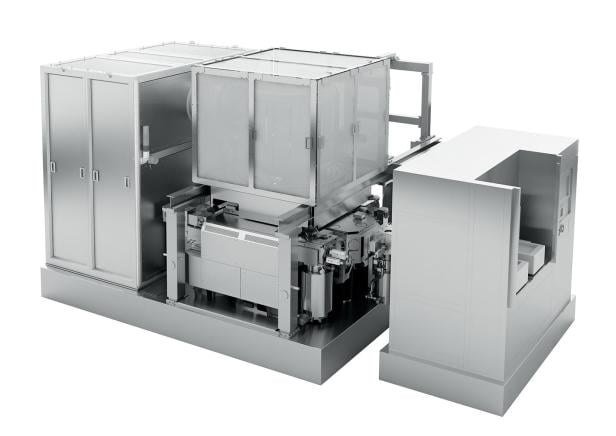Computer chips are etched into such silicon wafers.
© APA/dpa/Sebastian Kahnert / Sebastian Kahnert
A world without Computer chips can hardly be imagined today. The processors are installed in almost every device. They ensure that the coffee machine works, control the lights and engine in the car and enable us to network virtually with our smartphones and computers.
chip maker like Intel, Samsung or that taiwanesische TSMC are among the most valuable companies in the world, the Apple supplier TSMC is valued at $414 billion such as the most valuable listed company in Asia. But the computer chip manufacturing chain is only as strong as its weakest link, and countless links are intertwined. A particularly important one is located with IMS Nanofabrication for example in Austria.
Market leader in “electron multi-beam mask writers”
The company is hardly known outside of the industry. This is probably due to the fact that IMS Nanofabrication is deeper in the production chain. In order to be able to produce the chips at all, several highly complex machines are required. IMS Nanofabrication specializes in one of them. The company, with its headquarters in Brunn am gebirge, provides Electron multi-beam mask writer here. These mask writers can be used to make photomasks that act as a kind template used for computer chips.
This is what the electron multi-beam mask writer looks like.
© IMS Nanofabrication
The production of computer chips can be roughly imagined as a sophisticated printing process. Such chip printers are made by Dutch manufacturers ASML built, 2022 were loud corporate report almost 350 sold. The expensive machines cost up to 200 million euros per piece, the next generation of devices should cost more than 300 million euros per piece. A price the chip giants are willing to pay.
But the machines from ASML are only part of the production. “Without photomasks, the 150 million expensive machines are just paperweight”, it says in one Message of the semiconductor expert Dylan Patel. He estimates the market share of IMS Nanofabrication’s multi-beam mask writers to be over 95 percent. The demand for the machines from Lower Austria is correspondingly high.
Exposure of silicon wafers
To understand the success of IMS Nanofabrication, one must first understand how microchips are made. Thin slices out silicon be with Photo varnish covered, which hardens when exposed to light. The uncured areas are removed and the photoresist is peeled off again. Then the whole process starts all over again, up to 70 exposure steps are necessary for complex chips.
Photomasks come into play to direct the light to where the photoresist needs to be cured. They serve as projection templates for the chip structures and must be replaced with each exposure step. The masks themselves are made in a similar way to the chips, but instead of using ultraviolet light, electron beams used for “exposure”. In this way, much finer structures can be worked out than with light rays.
Faster and more accurate
While the competition from IMS Nanofabrication works with just one beam, the Austrian company’s machine writes 262,144 electron beams. The more complex process has the advantage that masks can be made much faster – under 10 hours – can be made. The competition takes 5 to 6 times as long.
But IMS Nanofabrication is not only world class in terms of speed, but also in terms of accuracy. As one of the few manufacturers, the Austrian company can produce mask writers for a 5-Nanometer-Chiparchitektur and create underneath.
As a rule of thumb, the smaller the structures can be made, the closer together the transistors can be arranged on a chip. This makes them more efficient, they create more computing power with less or the same power consumption. Apple uses the 5-nanometer architecture in both its M2-Chipsthat are built into Mac computers as well as the A15 and A16 chips of the latest iPhones.
Hidden company of millions
At futurezone’s request, IMS Nanofabrication is closed. Neither questions about turnover, customers, approximate costs per mask writer nor the number of employees are answered. Instead, it is pointed out that unfortunately data on the strategic orientation of the company cannot be shared. Economic figures for the company are correspondingly rare. The German Fraunhofer Institute for Silicon Technology, a partner of IMS Nanofabrication, credited the company with annual sales of in 2021 $400 million (EUR 365 million). Based on the round 500 employees this is an extremely good value.
IMS Nanofabrication is also closely associated with the Taiwanese company TSMC, the cooperation goes back years. In 2012, the chip manufacturer participated in the development of their mask writer – at that time still in the 10-nanometer architecture. Another partner at that time was the American one Semiconductor giant Intelwhich quietly bought IMS Nanofabrication in 2016 and turned it into a subsidiary.
Intel boss: “Almost the only manufacturer of EUV masks”
Intel-Chef Pat Gelsinger paid a visit to IMS earlier this year and praised their development: “IMS is almost the only manufacturer of EUV masks. It’s exceptional technology and a core piece to that Moore’s Law to be able to continue.” This law states that the number of transistors on computer chips is about every 2 years doubled.
Incidentally, IMS Nanofabrication sent him a plaque to mark the debut of Gelsinger, who has been in charge of Intel’s business since February 2021. This was engraved with 262,000 electron beams: “Together we will write Intel’s future”.




